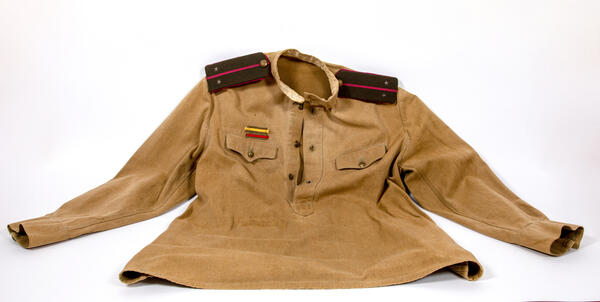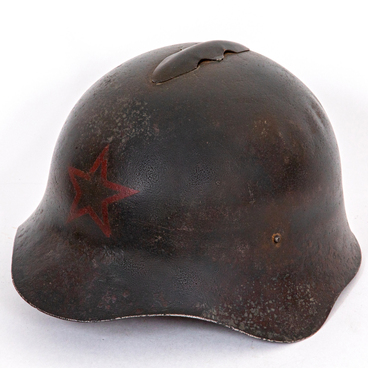As a type of combat uniform, a gimnasterka was first worn by the soldiers of the Russian Imperial Army stationed in Turkestan in the 1870s. It was mandated to be worn by the soldiers of the lower ranks ‘during hot summers’ with fastened shoulder-boards.
The name of this uniform comes from the gymnastic shirt, a soldier’s piece of clothing for physical exercises, which was introduced in 1862. The cut of the shirt was simple — a piece of cotton cloth was folded in half and sewn on the sides. Then the neck was cut out and decorated with a low standing collar and a small front closure with hooks or buttons. Sleeves without cuffs were then sewn to the body of the shirt.
The gimnasterka was popular not only among the military but also with the civilian population. It was cheap and easy to produce, and easily hemmed according to the height and size of a person.
Initially, gimnasterkas were white. Its protective greenish-gray color was introduced during the military reforms of 1905-1912. During the First World War, officers and military doctors were allowed to replace their field jackets with wool gimnasterkas, which differed from the soldiers' gimnasterkas, as they had pockets.
After the October Revolution of 1917, the gimnasterka became part of the uniform of soldiers and commanders of the Workers' and Peasants' Red Army. Following the order of the Revolutionary Military Council of the USSR in 1929, it was a ‘summer shirt with elbow patches of the 1931 version for all branches of the armed forces’. Occasionally, the cut, the material, the shape of the collar, the location of pockets, the plackets, and other details were changed, but up until 1943, the gimnasterka remained a mandatory element of all types of uniforms: field, service, and parade uniforms.
In 1943, the Red Army adopted a new uniform and changed the system of insignia. The gimnasterka was mandated for privates and sergeants as an element of the field and service uniforms, and it for senior and supreme commanders as an element of the field uniform. Instead of a detachable collar, the gimnasterka had a standing collar, which fitted better with shoulder-boards. It was fastened with two buttons. Sleeve insignias of gimnasterkas were canceled, and colored stripes, indicating wounds, were also introduced. The gimnasterkas of privates and sergeants still had no pockets, while the officers' pockets were replaced with attached pockets, covered with laps. The gimnasterka housed in the museum collection fits the military regulation description of the 1943 military uniform.
The name of this uniform comes from the gymnastic shirt, a soldier’s piece of clothing for physical exercises, which was introduced in 1862. The cut of the shirt was simple — a piece of cotton cloth was folded in half and sewn on the sides. Then the neck was cut out and decorated with a low standing collar and a small front closure with hooks or buttons. Sleeves without cuffs were then sewn to the body of the shirt.
The gimnasterka was popular not only among the military but also with the civilian population. It was cheap and easy to produce, and easily hemmed according to the height and size of a person.
Initially, gimnasterkas were white. Its protective greenish-gray color was introduced during the military reforms of 1905-1912. During the First World War, officers and military doctors were allowed to replace their field jackets with wool gimnasterkas, which differed from the soldiers' gimnasterkas, as they had pockets.
After the October Revolution of 1917, the gimnasterka became part of the uniform of soldiers and commanders of the Workers' and Peasants' Red Army. Following the order of the Revolutionary Military Council of the USSR in 1929, it was a ‘summer shirt with elbow patches of the 1931 version for all branches of the armed forces’. Occasionally, the cut, the material, the shape of the collar, the location of pockets, the plackets, and other details were changed, but up until 1943, the gimnasterka remained a mandatory element of all types of uniforms: field, service, and parade uniforms.
In 1943, the Red Army adopted a new uniform and changed the system of insignia. The gimnasterka was mandated for privates and sergeants as an element of the field and service uniforms, and it for senior and supreme commanders as an element of the field uniform. Instead of a detachable collar, the gimnasterka had a standing collar, which fitted better with shoulder-boards. It was fastened with two buttons. Sleeve insignias of gimnasterkas were canceled, and colored stripes, indicating wounds, were also introduced. The gimnasterkas of privates and sergeants still had no pockets, while the officers' pockets were replaced with attached pockets, covered with laps. The gimnasterka housed in the museum collection fits the military regulation description of the 1943 military uniform.



